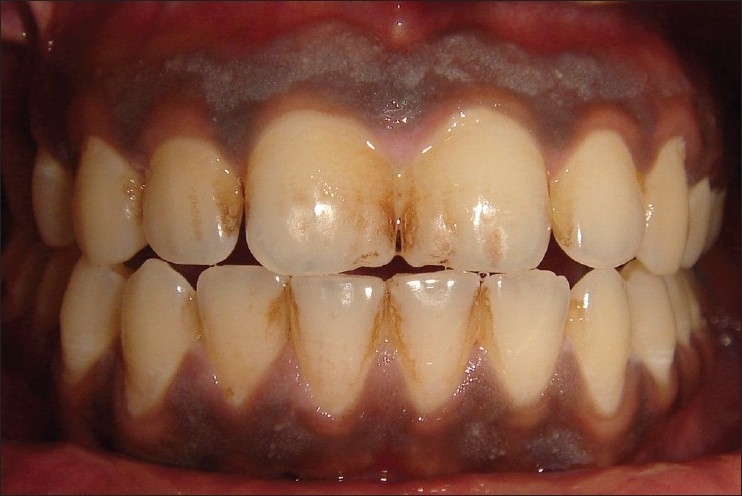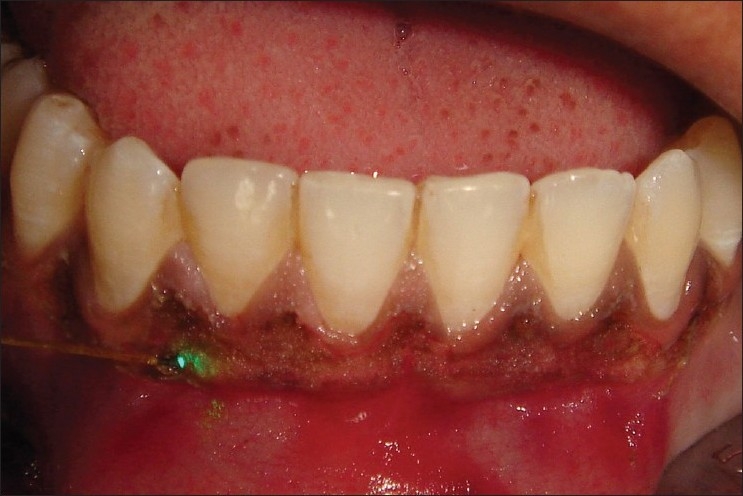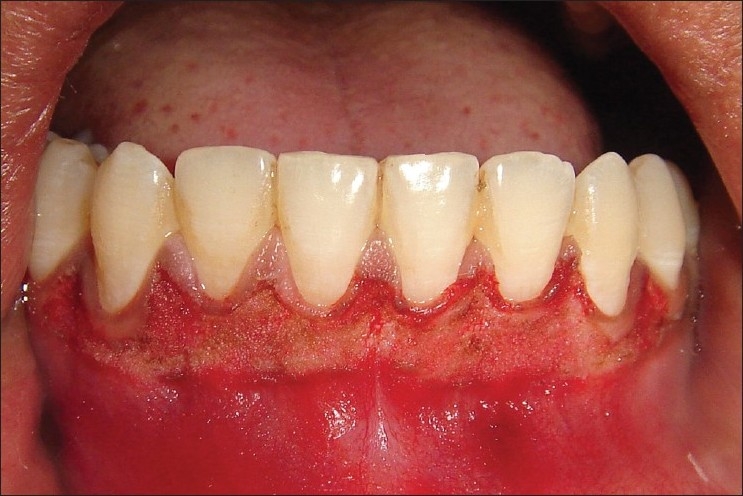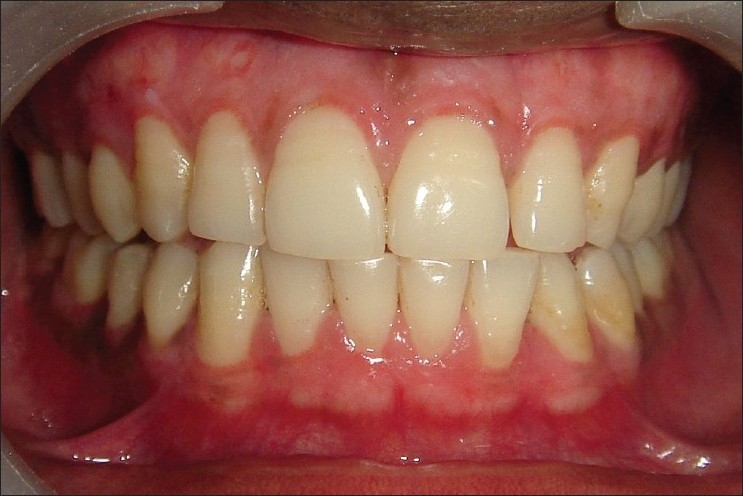Abstract
Gingival hyperpigmentation is caused by excessive deposition of melanin in the basal and suprabasal cell layers of the epithelium. Although melanin pigmentation of the gingiva is completely benign, cosmetic concerns are common, particularly in patients having a very high smile line (gummy smile). Various depigmentation techniques have been employed, such as scalpel surgery, gingivectomy, gingivectomy with free gingival autografting, cryosurgery, electrosurgery, chemical agents such as 90% phenol and 95% alcohol, abrasion with diamond burs, Nd:YAG laser, semiconductor diode laser, and CO2 laser. The present case report describes simple and effective depigmentation technique using semiconductor diode laser surgery – for gingival depigmentation, which have produced good results with patient satisfaction.
KEYWORDS: Depigmentation, hyperpigmentation, lasers, repigmentation
INTRODUCTION
Aesthetics has become a significant aspect of dentistry and clinicians are faced with achieving acceptable gingival aesthetics as well as addressing biologic and functional problems. Melanin, a brown pigment, is the most common natural pigment contributing to endogenous pigmentation of gingiva.[1] Various methods of de-epithelialization of the pigmented areas of the gingiva have been documented such as bur abrasion, surgical scraping, cryotherapy, electrosurgery and laser therapy. Selection of a technique should be based on clinical experience and individual preferences.
Lasers have been used in dentistry since the beginning of the 1980s.[2] Different lasers such as carbon dioxide (CO2) laser, Nd:YAG laser, semiconductor diode laser, argon laser, Er:YAG laser and Er,Cr:YSGG laser have been reported as effective, pleasant and reliable method with minimal postoperative discomfort and faster wound healing for depigmentation procedure.[3] The diode laser is a solid-state semiconductor laser that typically uses a combination of Gallium (Ga), Arsenide (Ar), and other elements, such as Aluminum (Al) and Indium (In), to change electrical energy into light energy.[4]
Dental laser energy has an affinity for different tissue components. The 810-nm diode laser has energy and wavelength characteristics that specially target the soft tissues. It has an affinity for hemoglobin and melanin, therefore it is more efficient and better equipped to address deeper soft tissue problems.[5]
CASE REPORT
A 23-year-old male patient complaining of heavily pigmented gums [Figure 1] visited department of Periodontics, Institute of Dental Studies and Technologies, Modinagar. On examination, the patient was otherwise healthy but had a deeply pigmented gingiva. Pigmentation was unsightly and hence laser depigmentation procedures were planned. The procedure was explained verbally to the patient and the consent was obtained.
Figure 1.

Pre-op photograph showing pigmentation of maxillary and mandibular gingiva
Patient and operating staff wore special diode-laser protective eye glasses. Highly reflective instruments or instruments with mirrored surfaces were avoided as there could be reflection of the laser beam. A semiconductor diode surgical laser unit (Sunny Gold; Mikro Scientific Instrument Pvt Ltd., India, wavelength 980 nm, power 2-4 W) was used for depigmentation of the maxillary and mandibular anterior gingiva up to the second premolar on both right and left sides. The semiconductor diode laser was emitted in gated-pulsed mode, and was operated in a contact method using a flexible fiber optic handpiece. The Laser settings used were: fluence between 5 and 15 J/cm2, pulse length between 20 and 50 ms, spot diameter of 2 mm and thermal relaxation times of 0.15 to 0.20 milliseconds. No topical or local anesthesia was given to patients. Laser ablation started from the mucogingival junction toward the free gingival margin, including papillae. The motion of ablation was circular with overlapping circles. High attention was taken to avoid passing the laser beam on teeth structures and over mucosa. During the procedure, laser ablated the gingival epithelial surface little by little to reach the pigments without causing any bleeding which was beneficial for clear visualization. [Figure 2] To enhance visualization, normal saline-soaked cotton or gauze was used to remove epithelial remnant.
Figure 2.

Depigmentation using diode laser
The ablation of the gingiva was completed within 20-25 minutes on the maxilla and mandible. Laser ablation of pigmented epithelium immediately produced a melanin pigment-free surface without any carbonization. The wound looked fresh with no bleeding [Figure 3]. There was no need to apply a periodontal dressing. Patient was instructed to avoid smoking and eating of hot and spicy foods for the first 24 hours and was discharged from dental office to perform normal daily activity. Healing was good at 1 month with pink color comparable to nearby non-treated area, resulting in a significant improvement in aesthetic appearance [Figure 4]. No infection or significant postoperative complications such as pain or bleeding were encountered. Fifteen months follow-up showed no signs of recurrence of pigmentaion.
Figure 3.

Immediate post-op photograph
Figure 4.

One month postop photograph showing aesthetically pleasing, depigmented maxillary and mandibular gingiva
DISCUSSION
Gingival hyperpigmentation is a major concern for patients and many a times forces the patient to seek cosmetic treatment. Although several techniques are currently in use, a one-step laser treatment is usually sufficient to eliminate the pigmented areas and do not require any periodontal dressing. This has the advantages of easy handling, short treatment time, hemostasis, and decontamination and sterilization effects. But this approach needs expensive and sophisticated equipment that is not available commonly at all places and makes the treatment very expensive.
The semiconductor diode laser is emitted in continuous- wave or gated-pulsed modes, and is usually operated in a contact method using a flexible fiber optic delivery system. Laser light at 800-980 nm is poorly absorbed in water, but highly absorbed in hemoglobin and other pigments.[6] Since the diode basically does not interact with dental hard tissues, the laser is an excellent soft tissue surgical laser, indicated for cutting and coagulating gingiva and oral mucosa, and for soft tissue curettage or sulcular debridement. The usage is quite similar to electrocauterization. Tissue penetration of a diode laser is less than that of the Nd:YAG laser, while the rate of heat generation is higher. The advantages of diode lasers are the smaller size of the units as well as the lower financial costs. Diode laser did not produce any deleterious effect on the root surface. Thus, it is generally considered that diode laser surgery can be performed safely in close proximity to dental hard tissue.[4] Q-switched Nd:YAG, Ruby and Alexandrite laser have also been used with favorable results. Q-switching leads to much lower pulse repetition rates, much higher pulse energies, and much longer pulse durations.
Although healing of laser wounds is slower than healing of scalpel wounds, a sterile inflammatory reaction occurs after lasering.[7] Blood vessels in the surrounding tissue up to a diameter of 0.5 mm are sealed; thus, the primary advantage is haemostasis and a relatively dry operating field.
There is little information on the behavior of melanocytes after surgical injury. Spontaneous repigmentation has been shown to occur and the mechanism suggested is that the active melanocytes from the adjacent pigmented tissues migrate to treated areas.[8] The large variation in time of repigmentation may be related to the technique used and the race of the patient. Repigmentation may also be attributed to the melanocytes which are left during surgery as stated by Ginwalla et al.[9] These may become activated and start synthesizing melanin.
This case did not show any recurrence of pigments after 15-month follow-up. No repigmentation was found in any of the four patients treated by Atsawasuwan et al,[10] at 11-13 months after gingival depigmentation using Nd:YAG laser. Nakamura et al,[11] described depigmentation with CO2 laser in 10 patients. No repigmentation was seen in the first year, but four patients showed repigmentation at 24 months. Tal et al,[12] and Berk et al,[13] observerved no repigmentation occurring in any of their patients treated with Er:YAG laser after 6 months.
The method used here produced desired results and above all, the patient was satisfied with the outcome, which is the ultimate goal of any therapy that is carried out. Although, larger series of patients is needed to offer conclusive evidence of the efficacy and safety of the procedure but with proper adhesion to safeguards, diode laser can be used to remove gingival pigmentation efficiently.
Footnotes
Source of Support: Nil.
Conflict of Interest: None declared.
REFERENCES
- 1.Humagain M, Nayak DG, Uppoor AS. Gingival depigmentation: A case report with review of Literature. J Nepal Dent Assoc. 2009;10:53–6. [Google Scholar]
- 2.Esen E, Haytac MC, Oz IA, Erdoğan O, Karsli ED. Gingival melanin pigmentation and its treatment with CO2 laser. Oral Surg Oral Med Oral Pathol Oral Radiol Endod. 2004;98:522–7. doi: 10.1016/j.tripleo.2004.02.059. [DOI] [PubMed] [Google Scholar]
- 3.Suthprasertporn S. Treatment of gingival melanin hyperpigmentation by Er,Cr:YSGG laser: Report of 2 cases. Thai J Periodontol. 2007;1:46–55. [Google Scholar]
- 4.Lagdive S, Doshi Y, Marawar PP. Management of gingival hyperpigmentation using surgical blade and diode laser therapy: A comparative study. J Oral Laser Appl. 2009;9:41–7. [Google Scholar]
- 5.Miyasaki MA. Shedding light on the soft tissue laser. Signature. 2004;11:11–3. [Google Scholar]
- 6.Lagdive SB, Lagdive SS, Marawar PP, Bhandari AJ, Darekar A, Saraf V. Surgical crown lengthening of the clinical tooth crown by using semiconductor diode laser: A case series. J Oral Laser Appl. 2010;10:53–57. [Google Scholar]
- 7.Ozbayrak S, Dumlu A, Ercalik-Yalcinkaya S. Treatment of melanin pigmented gingiva and oral mucosa with CO2 laser. Oral Surg Oral Med Oral Pathol Oral Radiol Endod. 2000;90:14–5. doi: 10.1067/moe.2000.106396. [DOI] [PubMed] [Google Scholar]
- 8.Perlmutter S, Tal H. Repigmentation of the gingiva following surgical injury. J Periodontol. 1986;57:48–50. doi: 10.1902/jop.1986.57.1.48. [DOI] [PubMed] [Google Scholar]
- 9.Ginwalla TM, Gomes BC, Varma BR. Surgical removal of gingival pigmentation. (A preliminary study) J Indian Dent Assoc. 1966;38:147–50. [PubMed] [Google Scholar]
- 10.Atsawasuwan P, Greethong K, Nimmanon V. Treatment of gingival hyperpigmentation for esthetic purposes by Nd: YAG laser: Report of 4 cases. J Periodontol. 2000;71:315–21. doi: 10.1902/jop.2000.71.2.315. [DOI] [PubMed] [Google Scholar]
- 11.Nakamura Y, Hossain M, Hirayama K, Matsumoto K. A clinical study on the removal of gingival melanin pigmentation with CO2 laser. Laser Surg Med. 1999;25:140–7. doi: 10.1002/(sici)1096-9101(1999)25:2<140::aid-lsm7>3.0.co;2-7. [DOI] [PubMed] [Google Scholar]
- 12.Tal H, Oeglesser D, Tal M. Gingival depigmentation by Erbium:YAG laser: Clinical observation and patient responses. J Periodontol. 2003;74:1660–7. doi: 10.1902/jop.2003.74.11.1660. [DOI] [PubMed] [Google Scholar]
- 13.Berk G, Atici K, Berk N. Treatment of gingival pigmentation with Er,Cr:YSGG Laser. J Oral Laser Appl. 2005;5:249–53. [Google Scholar]


